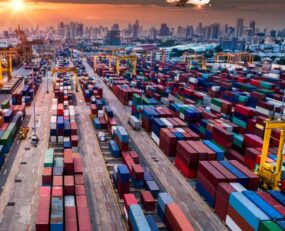
It has long been an ambition of many of the world’s largest air and ocean forwarders to win additional business from SMEs. However, with the widespread rollout of online freight quotation and booking platforms, there has been a renewed forwarder focus on SMEs.
For example, Agility’s recent launch of its platform Shipa Freight very explicitly targets SMEs. “Shipa Freight is a simple, technology-driven answer for small and medium-size businesses trying to take the complexity out of their international shipping,” said Agility CEO Tarek Sultan. “It gives them the transparency, flexibility, competitive pricing and customer service that the industry offers only to multi-nationals and high-volume customers.”
But just how important are SMEs to global trade? Data on the subject is relatively scarce, though there are some helpful sources.
Eurostat data on the value of extra-EU trade (which is primarily air and sea freight, rather than intra-EU trade, which has a far higher share of road and rail freight) for industrial goods (primarily manufacturing, excludes service and non-forwarding intensive sectors) suggests that large shippers on average across the EU account for 73% of imports and 69% of exports. To be clear, this implies that SMEs (businesses with less than 250 employees) account for 27% and 31% of imports and exports respectively.
Average share of value of trade by enterprise size (industrial goods only) across EU countries 2015 (latest data available)
Source: Eurostat
It is worth emphasising that this data reflects the value of trade, and that the proportions for air tonnage and ocean TEUs could be quite different. Such data is not publicly available however, and this is a topic that Ti will investigate further in its upcoming Global Freight Forwarding 2018 report*.
The figures are also an average for 26 EU countries (no data available for Malta and Cyprus). Looking at the distribution, for imports, large shippers account for:
For exports, the figures are reasonably similar:
The averages are therefore quite meaningful; the variance is not extreme.
What about other geographies? To repeat, data is scarce, but one interesting study shines a light on the importance of the very largest firms in emerging markets. According to a paper by Freund and Pierola (2015), on average, across a sample of 32 developing countries, a country’s largest exporting firm alone accounts for about 15% of non-oil exports, and the top five exporters account for on average one third of exports.
A follow-up paper (Freund and Pierola, 2016) which digs deeper into the origins of so-called “export superstars” has a very interesting conclusion: “From a policy perspective, the research underscores the importance of allowing firms to grow large to expand trade. While countries often seek to encourage small and medium-sized enterprises to export, such policies are unlikely to have large aggregate effects. Instead, it is important that the business climate is conducive to rapid firm growth and that it does not discriminate against firms of any size.”
At least for emerging markets then, this is something of a dampener of the role that SMEs play in international trade. An optimist however may argue that it simply reflects that SME trade is under-developed, especially in emerging markets. With e-commerce making sales to international markets easier, and technology such as online platforms reducing the complexity of global trade, it is conceivable that SME trade growth could accelerate over the coming years.
Having said that, there are clearly many other factors at work. What is clear is that there is plenty more to discover on SMEs and trade. As Agility’s CEO stated in a blog in January, the biggest revelation of a 2016 WTO report on SMEs was how little we know about them.
Source: Transport Intelligence, June 14, 2018
Author: David Buckby
* Ti’s upcoming Global Freight Forwarding report will feature a chapter on SMEs. To find out more, register your interest, or pre-order the report, please contact Michael Clover, Ti’s Business Development Manager: [email protected]